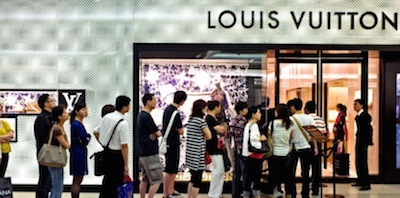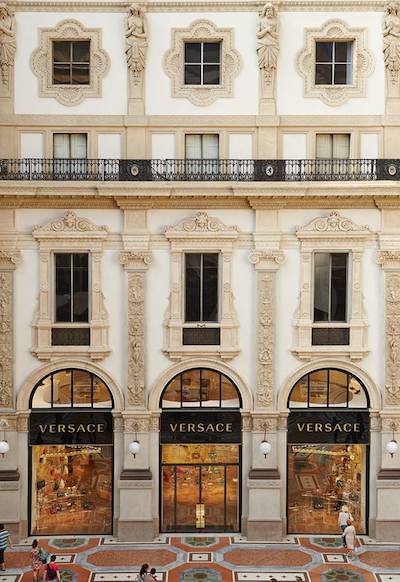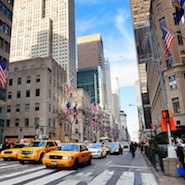New York is home to the most expensive retail real estate in the world, according to a new report by Cushman & Wakefield.
At $3,500 per square foot per year, Fifth Avenue from 49th Street to 60th Street, home to Saks Fifth Avenue, Louis Vuitton, Chanel and countless other luxury brands, is more than 50 percent pricier than the high street shops of Hong Kong’s Causeway Bay, which placed second. Real estate rates have risen amidst general economic uncertainty, but they are just one piece of the larger macroeconomic puzzle.
"The Americas region is expected to sustain a positive trajectory going forward into 2016, bolstered by a steady consumer sector benefiting from a material reduction in energy costs and stable employment expectations, especially in the U.S," said Gene Spiegelman, vice chairman, head of retail services, North America at Cushman & Wakefield. "Retailers will continue to add physical stores to support their expansion plans while at the same time optimizing their footprint to respond to the ongoing evolution of 'clicks and bricks.' International luxury brands will continue to dominate the high street, providing a boost to the key destination cities with high exposure from tourism and strong foot traffic."
“Main Streets Across The World” lists the most expensive street in each of 68 countries, but also includes analysis on other economic trends that will impact the retail picture.
High streets
Other noticeable placements include Paris' Avenue des Champs Élysées in third at $1,372 per square foot per year, New Bond Street in London right behind at $1,321 and Milan’s Via Montenapoleone rounding out the top five at $1,035.

Saks Fifth Avenue
The report also includes detailed, country-by-country breakdowns for major cities and streets globally, broken up by region. Champs Élysées rates remained close with last year’s but other Parisian high streets experienced high growth owing to a lack of space and high demand, while tourism and competition are contributing to high growth London, Milan and Rome.
In the Asia Pacific region, decelerating growth in China, a weak Japan, uncertainty in India and the rapid growth of ecommerce are no cause for alarm. Tokyo tourism could lead to strong growth, while Australia’s stable economy bodes well for the high streets of Sydney, Melbourne and Brisbane.
China is on course to become the world’s largest retail market by 2018 thanks to interest among retailers in having strong operations in Shanghai and developing Beijing into a shopping destination among developers.

Chinese consumers in line to enter a Louis Vuitton boutique
In the Americas, the United States accounts for the majority of the most expensive cities, and 27 percent growth in rates at Seattle’s high street and San Francisco’s tourism and never-ending tech boom situate them as markets to watch.
Among the macro trends to watch are the Chinese slowdown, which has been counteracted by a strong U.S. dollar and currency devaluation in Japan, South Korea and Europe. The latter has led to increased tourism among Chinese consumers with an express purpose of purchasing luxury products.
Tourism in general is growing, as a drop in petrol prices has led to lower airline rates and lower energy costs giving money back to the consumer. Lower oil and energy prices are part of a economic recovery larger trend in advanced economies, which counteracts the slowdown in emerging and fast-growing economies globally.

Versace store in Milan
Reflecting a global retail world, the report predicts a market that will grow in general but will have enormous differences among countries and be at the mercy of geopolitical stability and trade deficits. Aging populations in a number of markets and counteractive trends, from the end of the one-child policy in China to encouraging women to enter the labor force in Japan, will also play a big role.
Other major trends identified include accelerating urbanization, omnichannel retailing and technological breakthroughs and the impact of climate change and preventative measures.
World turning
Many of the mega-trends point toward the global consumer being a market reality that retailers must learn to reach.
Global heterogeneity presents many obstacles for brands looking to maximize their share through localization efforts, according to a September report from L2.
The share of ecommerce sales in the luxury industry has tripled since 2009 and is set to triple again by 2025, but obstacles such as currency, language, selection and payment method may make it difficult for brands to expand and capitalize on their reach. As social media, the Web and the development of BRIC Asian nations and Sub-Saharan African nations in the future give brands more visibility, it is essential that they monetize global consumers (see story).
Tourism and the global economy are already impacting consumers in a major way.
For example, high sales in Western Europe and Japan led to decent third quarter results for Kering, suggesting strong business from Chinese tourists.
The Kering Group saw luxury sales increase by 14 percent on a reported basis and slightly more than 3 percent on a comparable basis in the third quarter of 2015 compared to the year-ago. Much of this improvement can be attributed to a variety of economic factors taking Chinese consumers to Western Europe and Japan, where Kering’s presence is relatively strong (see story).
"Improving employment prospects, rising real wages and healthier consumer confidence in advanced economies are set to offer more positive momentum for the retail sector," said Justin Taylor, head of EMEA Retail at Cushman & Wakefield. "From an EMEA perspective, despite any economic and political uncertainties in certain countries, the retail market is expected to see further improvements. Indeed, a strong retail sales growth forecast, robust occupier demand and a lack of supply in many locations mean rents will keep rising in the most popular high streets."
Final Take
Forrest Cardamenis, editorial assistant on Luxury Daily, New York
{"ct":"iUQnfgl4UN9DQMrQPan3QKHsMa4mnOC8kS179CPHhzrRm6pAsXtPMSDWOV+8L1OxHIbN3ZWI2RKH\/QnppCnStXVVnBKvNsoJ4YuusL3lMjFOzD7tHMmAhSmyIbu73HdOGYs0XJkru07yV+GunOcV7VaDaxH4qg\/hhZeOH5XTXFCnIIaXDgASkiMWGwW9pRJErydgtDpHcsjv44QXpjJwcmsSP8IIJCdO8+YSSQ7Pg9iUAZXzSi76cIYOu3IzFHLEBU9o6IXa7EpwMnYZGEtxsHvgWtLSv\/9mvuPXjFCIwsoXI95rxNw0qLItGEsoNZSe1Q9hM9185jSJfOdTmaqwJVrxL944pzc5X\/INGJa7iLGpsxfJrXIIeH64tixDuRLmHo+j58KWgOnXMCxC4jm8TsZ\/dK2SUIJL29zE3DLqtGCbz+CTUMOZkSvcJosKk5VBezlD7ciVtijrByn+yPMwRvvuBO2nlFn9Wy91SN8yh0UVBhYWXV4lY\/c3Jd7MoO06QN5DVBj7PtU4jwOfvI1YcA6bY6e76FZLbpRU\/voi2AfgnjQiFHAiO0pZ4lMD\/6v5t3U8oEuADf2ZbVv9OBxYyO5XHAUAgzwXD\/DMp4MxVuwr32RbRB4YqkL8tij75A8ymwjES5e64ywtPRA7owy6apAHC8wQDYbgjEuDG8E3jQp\/jGlpdLb5RlBq8NJls+X0EXeXY\/mshIE\/D46+LSPCj3hAzKlTZBcNw1yfKcGW9VNA5vjnFwO7RD2bJgsIaoTitUT1jnaGQVdAflj+xX4a2tnawDZnBmQan0RX9N0vGUuEvP4mECH+i1YE2DNpFEvlOV1gLfL8pxE3guuTV7Wb84YFZ7mcYvtOFCBU5G8tld2HU6aMkF7pk1bcyTnQyLDa+NMXYJzjxjWI1Rd8oWe0QC4WNebzA0jCtjWn1V8OZT0uF7cLBqJhpjZubv0r\/eRkYgBBVaR65XU3d0dXGA43UbbkupiCR9xN9EZeGxIQ0c8gbW5NqvSL9LB0KpcUIs\/IJEGRmTJUt+W6reml2pZd81ZXRoWJ+7tZdm+3QMqxTHpH176e2QTfvowEFOQAVA8RwptowLpRcQUKCbw7Hf0omDGZCrCla7bnKSCfSddvUoAUIzBNkT34p0\/3MSpqqQPvu\/4cQzAnKcU2iTycwbHyy3ya7KuRk1P2HGVWsilRl1h9XhAeqhwEJN3cyWrOzn\/qjgs7rgjfOpiktziFHgpDjCpDY9Z24E05JtLZIj6UKYVCpqlrloBB5x65sSlXVKiYxprCbX1jPn0QiRWB7pz1Uy8yGvmtDfN8IeVGkk0luj3Bcc\/Icd7+proleb15a2lCVnnUJeMVRvMYSazJmw6k0Cp+NYX9hJ6XHqkpVI2ZlXJcjbmWpgeW3uXr4PrfeopgdFadkRCikbNJBU\/Ey+UiE7JguImOs2joBj5VJ9rej9EkIEgmGx1qQsxvb+qCjNOZk6QNtbeTapvDMKsQkvND8ljFCJdfWd+jxrH6CduyRsiQ8RELaJ40cQ\/XxXf+j82EHvhcSkj3+nv6e7GzjAjE+HoHqR94v6j8IkPb5VuWMOpr7RHNh88KgBQZvSSfJb0o2mHrTL\/n9AcRqGK2brJGZ\/Tpz10H060L6ovicM71A\/VmgoHkTf61iMbRhg4kNRCy3Lir8L\/vlXzALorK9o2Ji+B8mKwRMoxZQAJnJqLql4PVY+lz6NCcRYYGP53VOnE77V3xbqd8KO2N9ZC1BmJJuEsxbUFc\/JtrvSFLUNdR5WE8XKZeuKBxMDOFeIISnIK12dwPk2HJg8yE63s3ahZAf8LBNEQcB7zO77cV2dQnnHyoVC+QNnUBjm19UCwIoDS2dUuZy\/0olsu+0QN3i+bOl6Lbw6iOizgpADBC2IJIpiNZuc51xvlX7On3tSNoqhbZaj7Xo+qlIHAGI30\/GUgKTViqI1OoSP0ydVkUy4JenELazVolpOF0rNx1\/94OadniY2NeRY2M8MbjRP8J1alBOWbcWwINbgvHutZQvbOCS3vbWgZ0RFyPN8bPlC+8KgrszBZRlwKI8jqZeBPktDcDRHfQXhc8jLs6eUaBov0\/yKpnei5+obBdLCMFTQ8L1RNxscseLmNc+FTGjcCLYk85hWkO2aSP9ltLdTjcALySqN8rbZvD4me\/VvYH6u5eLWQ6sfkqegq8BwR1LRBjhT3EWFDVIHLbIf8OffdISH2nybbi6XmKTcLcgH4tH5voJqsy8F8v\/bd60ENTCMKnPrH3Pfg66UvL5MDfS6WkgCvB7BjwF5ffVeJH+FK\/JSCUmyvvIfgEOSBVNk+ZeNLDRpiUlpfTaouC2g7EJLRhy\/7TrUqcYsPtd\/SGIm1j3K0Ycm\/t8rqfTKYr5GKYUdIp9BNoYw8vcLhHSyeAOWZAS5oII81bOiFJzORrbU7m\/0vvUGJRBw1E2uDBwYqvTtAbw7xA553htBaUkhXihRpiIjn5mM6kJTTxifjJcpe7Y1yXHPh4Yw86MGIFmRI8BegquZChUhwT5M7kKOrJvyvYsK+sa0r5QKlcK2CHvDJuPCt5zGq22xMJBkZSQyrUgp+xO4JIsZC5AZ83SKMy1TDz5dnc1FijQvl\/Y\/FoHEPRXMuFYqS7ugPLWSInvg4v3CNh\/t+J4A2crW3z4qX+h5MOUF2UPCcXButh8wPByPmSypgzoofz\/yUSvl\/Cogrr60RVZrIJQAVnmSR\/o2DauTa9cMdXdTFw1Q\/r3DC5nkSZ6tfs1fEHRD3Br+8zulc0HZXaSfPuN33c34MkW88m9nmQQOnEJEd+c3oPPrQpTx5T7YoEcbe5X\/XQf1YC9XSNeaPCJ6RUPBw0vh1XHyXq3q3\/zsg9XX56F\/HMnRHmZZFvVC083msS4ISJ1WYnK4xGw0PkUpoldGYsJ+Ro4II\/vDOmFPviQQUDw\/+Jsnra3\/WvtXa3NJJ32LHhgiSpLsLASZJgiC85A8HdY0uSqWPIGp5Q9TOUiaptA8R5v3Cesousg9S08HUadtQWyjQTBptP849xYRBsqKgjKV3+DSTH0q1qADIq+fJUujLW6RApYZhh+ZaIyEMufvFGswJ2WiG5zHpGwN61q\/N6zKxH8bvhhMrEXh9roHvVU3153\/\/pDVBvAOuefwzSEMW8dDExn+YXeQLYqZ4+\/jFvBcNtvQ1L84sUvDvlWG14P2889StKvzTnAyhfbgeiiaLuvEgbT1XWcA6iibmpEQGzEnDFunZO7xp\/DiDOCoc9dfdu90lCfdZLz5EM0WQ4flkof8vgv\/KyGMgoIX8DwCVrNQY\/U39Zayws\/81CZKckUTJGxeDyAftKbP+H86l1DMakvhROB5PPEeIaN6hHypfxcsYq3L1UkvrHIEoDJlgNEYMZk6n8Wq5ybklPgq3251TZt+AQMVCs7tns9K+gw4vCb3Q\/D1+AdmoG1BdsHKrwCDElyxl8ABxPLJ90sr4fq8jSGG2kqHPTUb+ZOUSjW3HOQOkJlgW0T7FXyG4rm88qun096vCLEB+52bCU0ferhz3tI38b8wGlM1GZKNC1rz7eBqV6Cs0Qn9kdPOY55I+ct3\/RXa+jiAAkd5kKoo8vtpN864s6uRmlQazDsGgbuuVzUvXRsclNFp7tjsRZvNxuAMo\/o7LSysnZ\/9emztFPxgx4F\/xUpzcKOLIlkAYSDIqBOcK\/OHc6WJiplC2m3z8IKNkJwOy2F50c5RHrMUwyNM9id3Qc2RWkjuNxJJBIiwbgRHy+B5wawQHjWJEOoE7Hty4HpWb7hyc9YmWWGZ1X5KoPowZ7LH0ria\/pCdB+soVfJIt\/+HjoPr1cuElQqOoektyXvfhLUiVVcnV4J2sJ9sLrwwjN+uyZRuk\/lo8DzYSnWaQkrIbh7MXmywGLU+agJdTkY408Wg5EPUJbCvMmmAYtsqyapg2pRMrfxisKyTktn\/mMeDpqaMnw+rsQFxyKLDyQpjyFcNqhSkORDlDhZUhJg6uM+V4p68DyHGjKhOlJZ4mo0k5Mr6C0\/R7neMZJB\/MToEJ2NwtxZQyn7bZC0ScL+eYk4c8AovTWZMaSWvbfh4JYoiJKrhXg26O70BDlAp6gQhYUXDDldGcIEX3MBpKdY38496c8j0PU1BkQcJ6C+Ez3k4mgHNPM0krGUTiN3EUhQ8vgHkcVEZHaGJsQ2KzRsvACL2XKxapDrHGzBr\/f8q38TCfPzrMauJ1kYNZuyyjZm\/XgC3OmsyrJDNTk1mXWfnXXlXq1HqeqG+1b5e9hGmWCiKdI5zDkwsZw5Nk4McuXSzLoG5hvjUsZe8vY9LK5sg5mCuRqBFqnXoZRHJRKi01NVeTRcEmKiv08O0q3j5oGwwUarhVpWN08RGQtjGECFV5coZ8+LU\/kujGxx3F8ehZ1udyKXvai\/p0RFEeYqNBFPU1llvj7xoDU0KKE+iRANfLQpHY05bszJvG9F+5w2NJtdpcMgnp518sL+XXYNxuziAABOXyrS\/vPpbcPzW8O1jMTOStyA2svK6cykKqbjWSQk9BWRrtAujbIW15+qEhb7Ckte5AEdNnwNYEJP5H7GC0GWPll6icJX+64fUCXKrpgSlp6B8CP+cYjW1i+GuAkGiAlrS1zQAtK+\/VfvvfOxp+FiZyfrPHQjAfJY6C72s2ELkAjwNZo3\/grwrM6J01\/BQBgsfFzLdMOr26+0\/5m4H5\/3XKYAv5L1g\/Xpmkqy5uBUMdZP3ZHxt9WWIPhkZm1ot0Y5DiAKV95khT2GVizdWo30Z45XmvU\/+1vLqaAr5XqYahmSA0zT8z7+zsESjANw2ci17mvYOmhArlvaJZIWdMRXU9nXRvlPB0fMJGon1hrZ2u6chycWR\/ykx4ZvdbqcHHsdxQw2sIybp1Vlx8uLPxC0e\/gOCUB7FXr96ULtwow47O\/D\/JRRIE1yigBcz6iUjlU1DMYqnVHgrIXTBHu88NZbp0fuG7IChJRY6Gwbo7uAs3X3xQbEFZi3lW2VPQYVCapfYvSjdmg\/g1rIk+5MvhX6TarUuyHuUc\/VlNnKEOIFLcCrtRFkaSvzJKCFDhYUzM1D0bTBrF569taiOI2wZ+dLWZ6K4dJnigJ6bZubZn3mJiF6y9nsjtOmKluXC9RtPuanqgJMqxzysd1xWUbyDH50Elzig72ASy2l\/2tpWHlHfDRYXGG5oGl5aqB1reF5\/4AbCaQEDzVfEeNxUFqOleouCOODoMWuIlAgq667LHxxehpEuOHp9iB+RzmRjinbATdvLF7JZg9MWtWKvF6Vytq03USa7UBGaOjCUsc3Mv5cwZOZSFzPHXBHL5TLdaybFLpFMfOLDbuiuUYCWEHDXaPCs1lcZkMKzKhulcU3Ph3SJHkCB6kK0Oh\/JKg3v9hA5fVSqVzzI2FQ+5LWY4wPgnAqgd51QatLaGFZXoHB+HJqxz7BGO3V5r9SH6awYpmKqFHbJ85x5cNRjM\/TCAnsLKJrLodn\/5q+EIYtH3AalOAkZMGUxT0HKHxk2xqZj81Y59rsgUEUS3wiWIbsRNXVZnxTdgeypvuqlZrkbxGX8KE+9dBPTesf9whSBT9UOEi0+DSGzHnhHuWFnhNiu87EjzwHBrTYciVj0t0xlIgQq+M6aMTcs279YEmBXPfTmd3\/6S5wLlcIpk+b9\/wAW40gwbgifFRSJQlo29bJJfTuqQxCZoTywUXQsku7hbmTU9H+5SdlGNTv3cAuO2DwxnJCJGtuqtH4PFsqgHMN7JaFqbow7Cy9ape2R4lZxhQA2dnKJfckyjWmgrMzJYIBcoKNFowp4FFqx7seh6aYWNTN0npzavWSsKrXmYMiVvOEgPCQczt6B+fVs3KiB2\/pIHLJ9GRBPQKvuTh9M\/bC92zTVLTbW3gw\/FDMfwgxPxc0TomjB++ehRqsUkgxDSIAs4CT\/\/GcZR6ZtbHXtg5RZMNNkVsLz74XfQtiNJoxglBR9sDAOW5suzta\/5M07ylulrSCULqIh7IA82zI3G2Q9ke2prTDCBwY\/APpp+eHwfpTDGWHHNYStDs72Bp\/S6f4FdPnJQKB48HVjOvIVjEILdQyBMUU9yn9lugB5qW8NOn7Am4A+br3yaGsXlHyKWeBYaZPGpC+cAHOSvUVpqhUMEueHyAfAomUVnlkFvlILluSHzzHwkT6vGLXObI7BqPPQVmumwJHWWLCjocCr5lF0L0P1w+iVneUGHzVgyx8qUGBeTLuXlJuYS+Vj7UgrOVFaBxr2LGYy5lVyd1S6bkx5QCbsxriAUKVMzaEW1TmWy4laAMMK7TgOgKJa0QALXMBFukN4NPuO05yyg6UwPF2tpxbur6CtZeCKYVXdFcZTI0N9V5a3nn1VeZpqzPqCIgr3k7u2jv6Mgg+IMqed7P+1ACDq6Ri1Kzl+X53zQ99veLYyjBT0ahEdrtjWQs5TGblERZec8Bc67ZUxxpt56nQ5wgjN3GcE3tXY3LiYPBDTO0Kx0gkz8BUjc3RMUc+WHsYT5SJgbQAR6kapci7bkAPEiA287UZWsX97ACLSdNiXz2yXvJf\/tt2Y+rUr3exNa9OLF2DEqMpTTrU43mgKYLcz9osExiKeP71bUghI2zLce03KsqXsg++dQGmlgChSUy5Po2F\/kyEPQqGcU85dLE0obrXUDIlaD1UQdu6ThrplwHqFioIqpaswUWNGHp371fJFVyOPZHpTXbH6+4Ir2ncHiSe1zd3xxVFwEQIgbLKhPY5jAJ89O4XNUrV+Z\/j77QaDtS+fk0ikSVjrll9zDy9tBAedFDpO\/MlWGWA3CWZkuIOH8rrjVXBY7QrHzRgSMRmakLpGAJ4IzfwHAIZIqEEUdtu8YmssbYIrHJLIK7saQaPGrC0p56P3U\/0AK2J50G1y0m4BimSWYjtmPpiR72oiKh\/WKD8OlfOpQV9suQw0Zvsc8d4n0XjTsmiRIMlP2btGbI4D\/+U6Ie4s8\/HQbk7DIZlTg9xo+xDz7feAiat1ro3v4liULqCl0LncHqUjynU6UlndNGh\/QQzlXsAfJbpvoymlAsB7M3cVztWTscOrUbz58mhYHFuzEFHG+J\/Z\/R9Mj95ahIEOhbBr09aQM\/tGW7G2Nl\/+5N+L3RjUuYawrZ\/RE7dlUGoHBpybeVFzaKTTn3DcQw1L6Zp\/iXV1BuOK9xBi21t00rUEn0686y7zjixbTbTJ4Gt0Z\/oIotZyPkOauODuUqbsOSGR5sJ1BVu\/IDRpGXOHpFogE81ghzZ5mXL2GmnHfUJrMXk45ORS+wcJmIFVR+jNY8LrKWI8wB4WePOHBbO4wm2ySCSoheEvpmohLpELtJSn1cejrhPajuCESQNztckejkTvsWzc3YPGMZO417nSZvwSrm8aLiDgG5wlhlVZCIxslsweJIM3+QCy1Dd5Nz97uo6l2ihMO6rYeeGR5hmgB6zIlAm3XPEp6iIweLhZxjCq2GtWIp9ODA7LpmLMXcjHngGnP7TSHHzZVIZfMk7F1Ufy4SwaqV7tvATjU9pLV+i4fG3\/0Oi48txEiURa9IwxqP6PWPDXqeUAvYRaaZ6ROF6D+GFEyfLGE4O1uVW\/SX5DAuX5Aedd+IED\/W1OVgvbjpj0Tj04uhI4\/Apa2WtnVYDcP35QzzX6CYU8eOhmeRBzoY2QS1sh9wQocaPJfpBRClcupMl+M3OZDluu1hf+eoWzaWwpTUemheBccFDQTb1Ygh2RuDF8jSNagkTIyTUAAp5bfgQSqyiwDqhMfgXjZpG6Bhd6RrQXReLiSLMIuz70TbFQfxqheoDEAWqLuK1TtGT4Tl5NtHG8tmF0sIrykK\/fstGIzD54RYofVqMtdTkcvqRyYfcj3\/AHLdKgkiqIOBYTK5r89Yw1\/PpCccpkAPQjV6C075IBD8pXAqsRijUTG70EhqiRRYMhE5dN7fV3PQvyTpJMW+6vyFWMwKjW6yvUHrQzSeyUjoGAuvQ0UcfGm6zqDKJ3NDc3RyH+FFadYE8J+4QCL63Jp\/vQ8lTgwhmSYyNG3gJAy6mDx0bO4Q2TAva+F+gew6ljzyYOSTW+F0a3gAg+SKNzSm+YvhSnYpHFCahAPUPRCuZyJzk1m7vKc4M7S\/ZoK4gZdkDe+FaHsj+ObFE5nTOt3ogV\/VxMFiYOQIP\/gFGecWmYU+PfnIjD5aUySDYmMzTkdXnJ3muS\/SOEYimQ083Udj\/yj7PeC+GairFHwdSx+ICNa\/jLvGwwj+7aU6TvuppwIAqNDlPjhXlhANNNhzTCoX7BXZ5gnO2uzZlioMEKIy9L+H9kendeCnWwZMeHBwAHIX0tzqHMj5O3zBFgvXY7tbnRgKA8sWvD1bwPLzueOWKNyZqyuyauGMgs90uw9wy3oVh3p7WraL1jt2+zIgiAGYDeXwLidVCObZ+4KoOLl7Ir0+ODiv9MVgnH7H\/eAKIpiIAUyq4e3kGJKFP0+QcnIUCY79cW1tlMXDw0C2ovWrv8ZfEDOXmVV7pU\/aeMOmjdmtneeg3y+4ZRk69GYetrm7I+R+KxWpNbLhbwcoO2DQ+v1odYbtixl9rlenkg0fY0gfbCVgoVjQWMP1XmsSP5JhacUe\/VhktVe8Hi9KFaRUWqznW76BV9bd6sK4gtz5DZFSR22MB456Oy+\/v\/pgKNeC9yGxc+offmqX6lzQHs+6IV74Qz+rPyHNZOQRohkt3iqfMbjQKOeTS2ZfFzDKrhWgHS2ML9qRHRdW72UhVmkmrUK+eAKPR4N0fuJIVNwxyWtI5Iu5TRECHjZENkCsJCF3ZrUnhNRik8cQz1hXyaiW6aSC74iVGPoeWR0T0n6fN5myYenSp87xe1+1rouTrk+OEj4TEyovhQVNcEvISkctfulzMrlg6vRBZViEKmIopctjz3iIxyibOnqpySGzbuVJTys\/SShZkOhTMzZMopSVOB+2hWD6lMmAsjoGnGPxSPYKZIxTXCcsLnAj74dpjLZVfYmgJcWcNIps3lTcGN6U+RALboMOG+GkVNRCwSfEUJ1iSZP\/6C8\/6OK435El35jzqq+2FrKhOUKA22lsgjOET6aNdIE94SMClaXO9qVaGxpxrzkur4cjOoQg+PmaOvvr5rIXvgSke\/HeMHF65QtnGmribIMlFnJ9zP8n88TmHXcezbMlmJG1JYdSQ1Yf+K8iVPpy28YH6xRWXX+jGmjPNPqiU7q0\/31OlBbXcH8WdrYk+ffWN0Qj\/7bm9TQEUHNg2nhe4qDOr3SeXtulvz9X87kIx8M8ofkMKaid3\/DjDzBaSFUJeNW1qN8J5v16gqMdQWJtHw0ia1lv39qOvS8wD7a16IIlmqPseY9+2sJqkM42HNTkdogXOS0F0O6cn0V29HwV9FKyaWgBuSy18ILKtptysyzcfumWJLK0qh1e1rFPQwjl8\/b74xkqC6j0fYtWuEjtTardr3DRKgOm0FAfouD7HTieuRi6qhN26sswSv3VO6W117HYDsgh6C\/bib4YKE6PdvfSmDLfCwGXzi\/b4OVSXFsl0bOeUU14eHmQwsyYmbCRfdrK4FHgsiXrXebSAXDWhqdrmdK7H4ya5FduQyATNuD4fcHv7P4a2J7CbT3B8uk1sJP4G7HiOD7ceNm825YGmiVw1+iv4yxJNDrxv\/\/GHxyOkDnB89wuXon3cxLtTyf+hXKZvlAmICR7FpCMdMScfuPSwJsfAsBMtFvcBQtSXUkxfvXqTbOdHhX9Iv5t5lqDkBbWAjNAsWHVwaag+QqSrnfnvIccGSeJYWKMcT7EoiI1ONqtd2CBJbuFdw6lKSCIrY41kUAhg+ZMp5ftdWmjeZ17p+No3jc5unCWVc1tSaUQm2sa7sLwRCH9jy8OT0gueCrRESvPaxgv6WbCMNJ0dnvj79Pv+zWebsVjI4gGptV4klUYNP4vSFyiwOcqPuwfk\/Ru8k9WWZSVhcklmwHaSF9Kv1uV+9laxzPLP6HfZwCBcJIPWQPvu7A6\/bFwQNTSnCqRBwK2xxwuoZ0D3MDTe0sR7Y8PAOLVniV5nU5UZW\/qzyOiM70k0tyLUzSZDUboLhh8LQEUzZoZNraKPrIKPVO+KB2eRYDELRG++hcW6uFjKtVXlYP7MIKlyCqsPAgOatfEcNW+GPdGMsPRfxVfTs7xTIlT+EiIWr+8BmlQNN900MKXNgN9l0BLZVpXPkuYgJfC7W5o6AYUqujALwEOaS4DyLVmFohCDmJLDqnw7y2IRNX6cwrI27MJCZkhb24rh1AvySLLPzurO9yk0OE+5cnUVnwDBD1+C7f0atnMVbROvIeqk8KHPA7A3XbdKFyK84N6QjzLQPkVIq4kjFulYGUf16jY1KJNPV6xgzM12cKaAWQ5Db\/s2gAVDY6OAFiHZTZVy6f1hR824TpTWFPBklrIofe2pKcd6bghqaUVxNDqd7XmCH6z6JTw0Jeg8icdwQo5Q1w6IQ7I6j2Ds2WzUyvZlIGKl8Y+AQzMdS1iQbTz7B2gnyyPRsUSegW8U2u4125P\/7rkHTXRAW\/zZzGhkATS5bvfa163VHkEvBTjq\/6i1QbEU+Y03JH3n96v1IR+gVG5VKQjVOLtzGMVey\/EsncifLJlk2tVYBYxXjcfiZH6hndv7kbkR4WEyU8uoTM5HkiTq9nz5AXgnP2otXcz1LNlyCui04nl1bUl3iLOaPzCVO40qaxsAfzVnZPu71axCZpJp62JQVhhKCDKhuRQlHOxrJn3SEMP+Eh887hZLpc5sLi5gzMtinfouSc3aQm\/L+1pfRyExnQLVbdW+81M3VCVz66XT9WPinBYLFL4RKKGAoZ4QypnIfwWiAEQiakxl7pPpJ1WGE7ia6j5pioJIjUFWL06taPlJMSYyQXWMRgHANy3NDqxcON4l0ZTnwp5xZoafQYVBYLY9FlmsoiFO4hZeKKiHJbJoopG4\/p9FcIkNr5HlgxgZBNqwQt5zxLjIvy5zV4SLH+FmZnq\/1v15clPaz\/0jweNH3ulGieBaqkWKHugejicq3S2","iv":"cdf5a87bd00342b2f544559d8086305d","s":"5615aae169c905af"}
